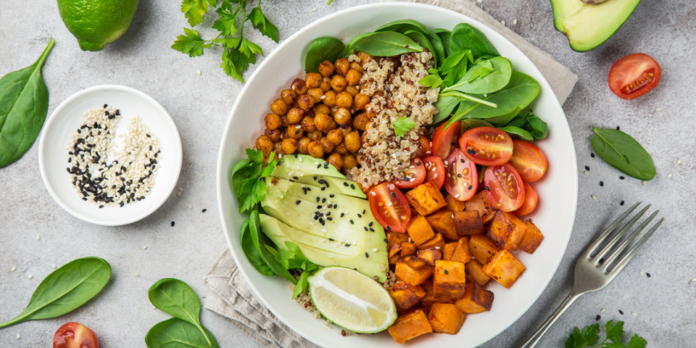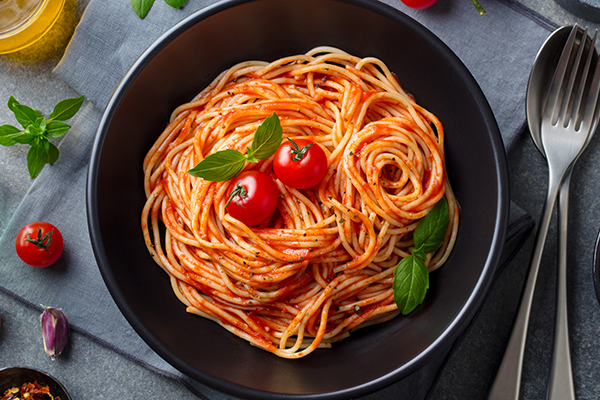With the galaxy of tech and fad diets that have recently emerged, many of us have become obsessed with “hacking” our nutrition. Along the way, however, we’ve forgotten about an essential concept: balance.
Yep, a balanced meal — that subject of elementary-school wheels and pyramids — goes a long way toward helping you realize your fitness goals, no matter what they may be.
What Is a Balanced Meal?
“A balanced diet will be different for each person, but all should have in common several traits including variety, moderation, adequate nutrient intake, and avoiding excess calories,” says Cary Kreutzer, EdD, MPH, RDN, FAND, an associate clinical professor at the USC Leonard Davis School of Gerontology.
How do you put that into practice? Look at each component of your meal as a portion of a plate.
Lisa Young, PhD, RDN, a registered dietitian nutritionist and adjunct professor of nutrition at NYU, says this breakdown is ideal (and can help with portion control):
- 1/2 the plate should be fruits and/or veggies
- 1/4 should be healthy starch (like brown rice, quinoa, or sweet potato)
- 1/4 should be healthy protein (like fish, chicken, beans, or eggs)
- Sprinkle in some added healthy fat, like olive oil or avocado
“Throughout the day, according to current guidelines, you should aim for 45 to 65 percent carbs, 20 to 35 percent fat, and 10 to 35 percent protein,” she says. “But it’s more important to focus on making healthy food choices than obsessing about the exact macronutrient ratio for each meal.”
The other experts we spoke with agreed.
Elements of a Balanced Meal
So you don’t need to get too hung up on precise calculations. Here’s what you do need to do:
“Try to get whole grains, vegetables, lean or plant-based proteins, and fruits into every meal,” advises Dana Ellis Hunnes, PhD, MPH, RD, a clinical inpatient dietitian at the Ronald Reagan-UCLA Medical Center.
“On average, it’s a good idea to incorporate three to four servings of vegetables and one to two servings of fruit per meal. It’s not as much as you think: cooked vegetables are generally 1/2 cup servings and raw vegetables are about 1 cup servings,” she adds.
And variety is important. “When we eat a variety of foods, we will likely meet our vitamin and mineral needs,” says Kreutzer. “The old saying, ‘Eat the rainbow‘ holds true today. The colors in fruit and vegetables provide different vitamins and minerals along with healthy fiber to feed our gut microbiome.”
4 Common Meal Mistakes
You’ll want to avoid these four pitfalls experts say they see all the time.
1. Over-consuming protein
“The typical American diet is higher in protein than the Recommended Daily Allowance suggests,” says Kreutzer. If you consume more protein than your body can use, the body converts it into glucose or fat, which can lead to weight gain.
The current RDA for protein is:
- 46 grams of protein per day for a woman aged 14 to 65
- 56 grams per day for a man aged 14 to 65
“If you consider that 3 ounces of meat contains 21 grams of protein, 1 cup of milk has 8 grams of protein and a slice of bread or cup of cereal has 3 grams of protein, it’s easy to see how one can exceed their daily needs,” says Kreutzer.
If you’re active or building muscle, you may need more protein. Read more about How Much Protein Do You Need?
2. Eating too much starch
“The biggest mistake many people make is eating too much starch and not enough veggies,” says Young.
“Half the plate should be veggies or fruits, and healthy starch should be one-fourth. Many people do it the other way around and fill up on too many white/refined grains, like white rice and pasta instead of brown rice and whole grain pasta,” she advises.
3. Simple carbs and processed foods
“Carbohydrate intake should focus on whole grains and whole fruits and vegetables instead of simple sugars found in sweets, treats, or ice cream,” says Kreutzer.
That’s because simple sugars burn faster than their more complex counterparts, spiking blood glucose levels before precipitating steep drops.
That typically makes you crave more, which is what often leads to weight gain and other potential problems.
4. Avoiding all fat
“Fat is a necessary nutrient, and consuming polyunsaturated or monounsaturated fats while limiting saturated animal fats is recommended,” says Kreutzer.
Examples of polyunsaturated and monounsaturated fats include plant-based oils (olive, avocado), whole avocados, nuts and seeds.
Remember — it’s OK to keep it simple.
“When I think of a balanced diet, I don’t necessarily think of breaking down everything into its constituent parts,” says Hunnes. “I tend to think more about the quality of the foods that I am eating. Generally, if you are eating a wide variety of whole-foods, plant-based proteins, a ton of vegetables, whole grains, and fruits, it doesn’t matter too much about proportioning them.”





